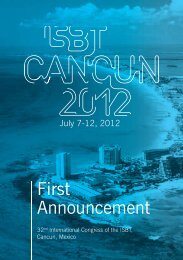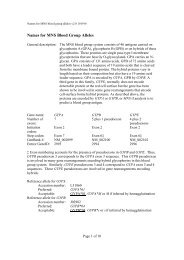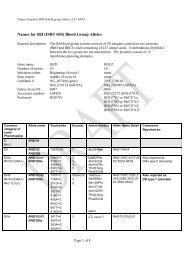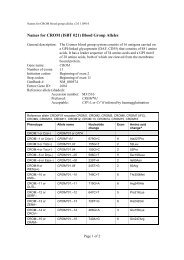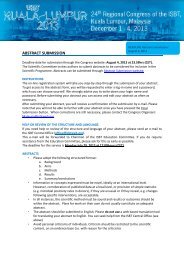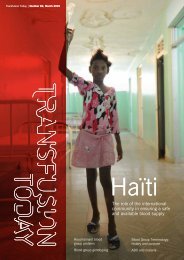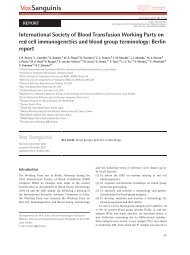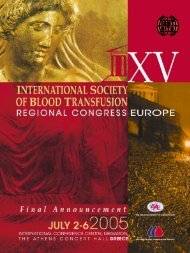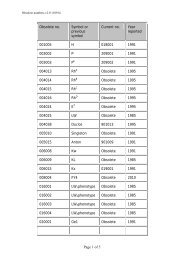Guidelines for the Use of RFID Technology in Transfusion Medicine
Guidelines for the Use of RFID Technology in Transfusion Medicine
Guidelines for the Use of RFID Technology in Transfusion Medicine
You also want an ePaper? Increase the reach of your titles
YUMPU automatically turns print PDFs into web optimized ePapers that Google loves.
18 Guidel<strong>in</strong>eBloodCare, Dallas, TX; and Mississippi Blood Services,Jackson, MS), <strong>in</strong> conjunction with <strong>the</strong> University <strong>of</strong> Wiscons<strong>in</strong>Madison <strong>RFID</strong> Lab, developed a model to determ<strong>in</strong>eimpact and return on <strong>in</strong>vestment <strong>for</strong> small, medium, andlarge blood centers. The model helps assess cost and benefitcomponents <strong>in</strong>volved <strong>in</strong> implement<strong>in</strong>g <strong>RFID</strong>-enabled processesand technologies on <strong>the</strong> blood center end <strong>of</strong> <strong>the</strong>transfusion medic<strong>in</strong>e supply cha<strong>in</strong>.Impact AnalysisThe impact analysis study associated with <strong>the</strong> ROI modelwas designed to estimate <strong>the</strong> impact that <strong>RFID</strong> will have onblood center operations <strong>in</strong> terms <strong>of</strong> productivity, quality,and safety. The Impact Analysis consists <strong>of</strong> three ma<strong>in</strong> sections:Bus<strong>in</strong>ess Pr<strong>of</strong>ile, <strong>RFID</strong>-Enabled Process Analysis, andOrganizational Impact Analysis.The Bus<strong>in</strong>ess Pr<strong>of</strong>ile gives <strong>in</strong>sight <strong>in</strong>to <strong>the</strong> size, operationalvolumes, resource availability, and f<strong>in</strong>ancial parameters<strong>of</strong> <strong>the</strong> organization, provid<strong>in</strong>g basel<strong>in</strong>es <strong>for</strong>quantification <strong>of</strong> both cost and benefits.The <strong>RFID</strong>-Enabled Process Analysis provides a snapshot<strong>of</strong> a blood center’s current pa<strong>in</strong> po<strong>in</strong>ts by process, type <strong>of</strong>event, and <strong>the</strong> frequency <strong>of</strong> occurrence. Three types <strong>of</strong>bus<strong>in</strong>ess metrics are measured: process efficiency, quality,and patient safety. Each organization should develop anestimate <strong>of</strong> <strong>RFID</strong> impact on <strong>the</strong>se three dimensions (metrics)noted earlier along with a description <strong>of</strong> <strong>the</strong> pa<strong>in</strong> po<strong>in</strong>ts.The Organizational Impact Analysis quantifies <strong>the</strong>impact <strong>of</strong> implement<strong>in</strong>g <strong>RFID</strong> on an organization’s personnel.It gives <strong>in</strong>sight <strong>in</strong>to <strong>the</strong> ef<strong>for</strong>t and resources required toprepare operations staff <strong>for</strong> <strong>RFID</strong> implementation <strong>in</strong> terms<strong>of</strong> tra<strong>in</strong><strong>in</strong>g, communication, and operational impact <strong>of</strong>implement<strong>in</strong>g new <strong>RFID</strong>-enabled processes. The tra<strong>in</strong><strong>in</strong>gef<strong>for</strong>t on <strong>the</strong> new processes will be estimated to <strong>the</strong> po<strong>in</strong>t <strong>of</strong>staff competency and will <strong>in</strong>clude a list<strong>in</strong>g <strong>of</strong> required skillsets. In order to achieve participants’ alignment with <strong>the</strong>new processes, <strong>the</strong> organization as a whole will require agood understand<strong>in</strong>g <strong>of</strong> <strong>the</strong> reasons <strong>for</strong> <strong>the</strong> change and <strong>the</strong>bus<strong>in</strong>ess <strong>in</strong>tent <strong>of</strong> <strong>the</strong> technology implementation.Cost/Benefit MethodologyAn Excel-based model has been developed to estimatecosts, benefits, net present value, and payback period. Thema<strong>in</strong> cost categories <strong>in</strong>cluded <strong>in</strong> <strong>the</strong> model are <strong>RFID</strong> tags,<strong>RFID</strong> hardware, IT <strong>in</strong>frastructure, s<strong>of</strong>tware, <strong>in</strong>tegration, andimplementation. The ma<strong>in</strong> benefit categories are productivity,quality, and patient safety. Input parameters arecollected by survey<strong>in</strong>g processes and technology owners,as well as bus<strong>in</strong>ess systems. Basel<strong>in</strong>e results are calculated<strong>for</strong> an average medium-to-large-sized blood center(200 000–250 000 collections per year).Cost AnalysisIn deploy<strong>in</strong>g <strong>RFID</strong> to all operations, <strong>the</strong> average mediumto-large-sizedblood center will experience <strong>the</strong> follow<strong>in</strong>gareas <strong>of</strong> cost over <strong>the</strong> 5 year plann<strong>in</strong>g horizon.• Start-up costs (Mostly fixed cost - hardware, s<strong>of</strong>tware,implementation, etc.)• Recurr<strong>in</strong>g costs: Variable (direct cost associated with<strong>RFID</strong> – usually <strong>the</strong> largest component and <strong>in</strong>direct cost).Benefit AnalysisIn deploy<strong>in</strong>g <strong>RFID</strong> to all operations, <strong>the</strong> average mediumto-large-sizedblood center will realize benefits <strong>in</strong> <strong>the</strong>follow<strong>in</strong>g areas:• Productivity ga<strong>in</strong>s• Reductions <strong>in</strong> unnecessary discarded product (improvedquality <strong>of</strong> operation)• Improvement <strong>in</strong> manufactur<strong>in</strong>g mix.The model weighs <strong>in</strong>frastructure and implementationcosts, costs over time along with materials, and quantifiesbenefits from <strong>the</strong> user <strong>of</strong> <strong>RFID</strong> based on <strong>the</strong> number <strong>of</strong>blood units collected annually. With <strong>the</strong> given model<strong>in</strong>gassumptions, it is possible to project <strong>for</strong> a medium-tolarge-sizedblood center <strong>the</strong> net present value (benefitsm<strong>in</strong>us cost) realizable over a 5 -year plann<strong>in</strong>g horizon. Themodel considers <strong>the</strong> rate <strong>of</strong> adoption by estimat<strong>in</strong>g <strong>the</strong>number <strong>of</strong> <strong>RFID</strong>-enabled blood products added each year to<strong>the</strong> supply cha<strong>in</strong>. The basic assumption is a gradual rollout<strong>of</strong> <strong>the</strong> technology across products and participants. Theestimated payback period (years to recover <strong>the</strong> <strong>in</strong>vestment)is <strong>the</strong>n calculated. For a medium-to-large blood center(200 000–250 000 collections per year), <strong>the</strong> model predictsa return on <strong>in</strong>vestment <strong>in</strong> 3.9 years. The ROI modelreflects results from a broader impact analysis; <strong>the</strong> ROI <strong>for</strong>larger blood centers will be achieved sooner and will takelonger <strong>for</strong> smaller blood centers. The models are availablefrom BloodCenter <strong>of</strong> Wiscons<strong>in</strong>, In<strong>for</strong>mation ServicesDepartment, PO Box 2178, Milwaukee, WI 53201, USA.Additional BenefitsBeyond <strong>the</strong> benefits that can be f<strong>in</strong>ancially quantified <strong>in</strong><strong>the</strong> cost ⁄ benefit model, stakeholders <strong>in</strong> <strong>the</strong> transfusionmedic<strong>in</strong>e supply cha<strong>in</strong> can expect additional benefits from<strong>RFID</strong> enablement. Most notably, an <strong>RFID</strong>-enabled systemwill enable an <strong>in</strong>frastructure <strong>for</strong> improv<strong>in</strong>g patient safetyon <strong>the</strong> hospital side by add<strong>in</strong>g a safety layer aga<strong>in</strong>stblood ⁄ patient mismatches, and potential improvements <strong>in</strong>process control and efficiency <strong>in</strong> <strong>the</strong> Blood Services.Sensitivity AnalysisBecause <strong>of</strong> <strong>the</strong> nature <strong>of</strong> <strong>the</strong> assessment process and accuracy<strong>of</strong> basel<strong>in</strong>e data use <strong>for</strong> projections, it is advisable toper<strong>for</strong>m a Sensitivity Analysis <strong>for</strong> projections calculated byÓ 2010 The Author(s)Journal compilation Ó 2010 International Society <strong>of</strong> Blood <strong>Transfusion</strong>, Vox Sangu<strong>in</strong>is (2010) 98 (Suppl. 2), 1–24



